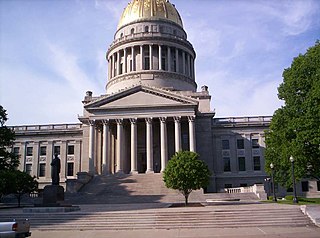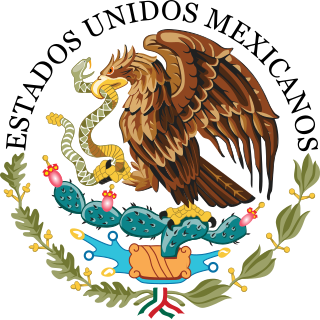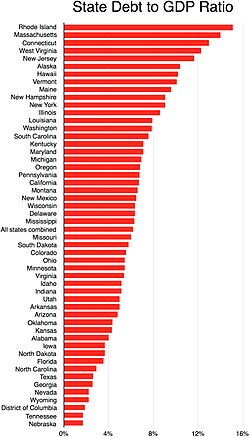In the United States, a state supreme court is the highest court in the state judiciary of a U.S. state. On matters of state law, the judgment of a state supreme court is considered final and binding in both state and federal courts.

The government of the Commonwealth of Puerto Rico is a republican democracy established by the Constitution of Puerto Rico in 1952. Under a system of separation of powers, the government is divided among three branches: the executive, the legislative, and the judicial. As a territory of the United States, the government of Puerto Rico is under the jurisdiction of the federal government of the United States.
The government of the U.S. state of Missouri is organized into the state government and local government, including county government, and city and municipal government.

The federal government of the United States is the common government of the United States, a federal republic located primarily in North America, comprising 50 states, five major self-governing territories, several island possessions, and the federal district of Washington, D.C., where the majority of the federal government is based.

The government of Maryland is conducted according to the Maryland Constitution. The United States is a federation; consequently, the government of Maryland, like the other 49 state governments, has exclusive authority over matters that lie entirely within the state's borders, except as limited by the Constitution of the United States.
The legislative veto was a feature of dozens of statutes enacted by the United States federal government between approximately 1930 and 1980, until held unconstitutional by the U.S. Supreme Court in INS v. Chadha (1983). It is a provision whereby Congress passes a statute granting authority to the President and reserving for itself the ability to override, through simple majority vote, individual actions taken by the President pursuant to that authority.
The Constitution of the State of New York establishes the structure of the government of the State of New York, and enumerates the basic rights of the citizens of New York. Like most state constitutions in the United States, New York's constitution's provisions tend to be more detailed and amended more often than its federal counterpart. Because the history of the state constitution differs from the federal constitution, the New York Court of Appeals has seen fit to interpret analogous provisions differently from United States Supreme Court's interpretation of federal provisions.

The government of the State of New Jersey is separated into three distinct branches: legislative, executive, and judicial. The powers of the State of New Jersey are vested by the Constitution of New Jersey, enacted in 1947, in a bicameral state legislature, the Governor, and the state courts, headed the New Jersey Supreme Court. The powers and duties of these branches are further defined by acts of the state legislature, including the creation of executive departments and courts inferior to the Supreme Court.

The state government of Georgia is the U.S. state governmental body established by the Georgia State Constitution. It is a republican form of government with three branches: the legislature, executive, and judiciary. Through a system of separation of powers or "checks and balances", each of these branches has some authority to act on its own, some authority to regulate the other two branches, and has some of its own authority, in turn, regulated by the other branches. The seat of government for Georgia is located in Atlanta.

The Government of the State of New York, headquartered at the New York State Capitol in Albany, encompasses the administrative structure of the U.S. state of New York, as established by the state's constitution. Analogously to the US federal government, it is composed of three branches: executive, legislative, and judicial. The head of the executive is the governor. The Legislature consists of the Senate and the Assembly. The Unified Court System consists of the Court of Appeals and lower courts. The state is also divided into counties, cities, towns, and villages, which are all municipal corporations with their own government.
Nullification, in United States constitutional history, is a legal theory that a state has the right to nullify, or invalidate, any federal laws that they deem unconstitutional with respect to the United States Constitution. There are similar theories that any officer, jury, or individual may do the same. The theory of state nullification has never been legally upheld by federal courts, although jury nullification has.
The Government of the Commonwealth of Pennsylvania is the governmental structure of the Commonwealth of Pennsylvania as established by the Pennsylvania Constitution. It is composed of three branches: executive, legislative and judicial. The state capital of Pennsylvania is Harrisburg.
The government of Virginia combines the executive, legislative and judicial branches of authority in the Commonwealth of Virginia. The current governor of Virginia is Glenn Youngkin. The State Capitol building in Richmond was designed by Thomas Jefferson, and the cornerstone was laid by Governor Patrick Henry in 1785. Virginia currently functions under the 1971 Constitution of Virginia. It is Virginia's seventh constitution. Under the Constitution, the government is composed of three branches: the legislative, the executive and the judicial.

The Government of Delaware encompasses the administrative structure of the US state of Delaware as established by its 1897 constitution. Analogously to the US federal government, it is composed of three branches: executive, legislative, and judicial. The Governor is head of the executive, the General Assembly is the legislature, and the Supreme Court is the highest court. The state is also organized into counties, municipalities, school districts, and special districts.

The Government of West Virginia is modeled after the Government of the United States, with three branches: the executive, consisting of the Governor of West Virginia and the other elected constitutional officers; the legislative, consisting of the West Virginia Legislature which includes the Senate and the House of Delegates; and the judicial, consisting of the West Virginia Supreme Court of Appeals and lower courts.

In the United States, a state is a constituent political entity, of which there are 50. Bound together in a political union, each state holds governmental jurisdiction over a separate and defined geographic territory where it shares its sovereignty with the federal government. Due to this shared sovereignty, Americans are citizens both of the federal republic and of the state in which they reside. State citizenship and residency are flexible, and no government approval is required to move between states, except for persons restricted by certain types of court orders.
In the United States, the government of each of the 50 states is structured in accordance with its individual constitution. In turn, each state constitution must be grounded in republican principles. Article IV, Section 4, Clause 1 of the United States Constitution tasks the federal government with assuring that each state's government is so organized.

The Federal Government of Mexico is the national government of the United Mexican States, the central government established by its constitution to share sovereignty over the republic with the governments of the 31 individual Mexican states, and to represent such governments before international bodies such as the United Nations.
The State government of Arkansas is divided into three branches: executive, legislative and judicial. These consist of the state governor's office, a bicameral state legislature known as the Arkansas General Assembly, and a state court system. The Arkansas Constitution delineates the structure and function of the state government. Since 1963, Arkansas has had four seats in the U.S. House of Representatives. Like all other states, it has two seats in the U.S. Senate.
In the United States, each state and territory has constitutional officers who lead the state governments of the United States. These officers may be elected or appointed, depending on the position. The number and powers of state constitutional officers varies from state to state, based on the constitution and statutes of each state. State constitutional officers may reside in the executive or legislative branch, while state constitutions also establish the judicial system of the state, including state supreme courts.













